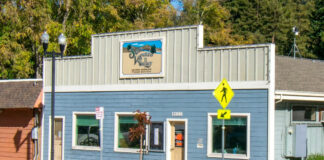The massive “slip-out” of the mountainside underneath the northbound lane of Highway 9, just south of Brookdale, resulted in more than 16 months of a temporary traffic signal and single lane access to Boulder Creek. For regular commuters, the long-awaited completion of the repair project appears noticeably close- scheduled for September.
The single, southbound lane was closed entirely most of the night of June 20 and June 21 for a concrete pour of more than 350 cubic yards of concrete on a carefully engineered deck, or viaduct, that now supports about 310 feet of the new northbound lane.
Responses to a conversation prompt from the Press Banner on the Boulder Creek Neighbors Facebook page mostly reflected a sense of resilience and patience with the project.
“We valley folk know how to deal with traffic and inconveniences caused by Mother Nature. I look at it as a game now, one without a loser. If I hit a red light, take a break…if hit a green, bonus!” responded Pete Petri.
Another resident, Christine Riley, responded, “I find people in the Valley seem to roll with what ever is thrown our way. While at times it may be inconvenient, and for me being the first car through is nail biting, I am thankful it has helped law enforcement catch folks attempting to elude capture.”
According to Caltrans Resident Engineer Katie Beach, the longest delays and added expenses were due, of course, to the unexpected. One example: despite alerting all utility companies, and despite meeting with AT&T before construction began, an AT&T-owned fiber optic cable turned out to be big surprise, and was broken early on in construction, temporarily disabling many computers in Boulder Creek for about one day. Oddly enough, this happened the same day as the Bear Creek Fire, which further complicated things, according to Beach.
“As with most projects, rarely does everything go as planned,” Beach said. It took approximately nine months between notifying the utility companies and having a cleared work site. The AT&T fiber optic line and the San Lorenzo Valley Water District (SLVWD) lines were worked around and relocated in a few places. Beach said she remains thankful to the SLVWD for being responsive and getting to the project site upon request to solve problems with water lines in the project area.
The second reason for relatively slow progress was the constrained work area, with a narrow lane and no shoulder to work from, requiring Highway 9 to be completely closed for 15 nights between October and November last year, and needing to accommodate traffic on the remaining lane during the day- between 12,500 and 16,000 vehicles per day.
The site constraints limited the size and efficiency of the heavy equipment necessary for the project, the amount of material that could be stored on site, and required careful scheduling of the work since the single lane access to Boulder Creek could not be interrupted for long periods of time.
Getting into some details of this project helps explains why it has taken so long, and why it is running more than 25 percent over the initial cost estimate. The new northbound lane is essentially a steel-reinforced concrete bridge deck, supported by seven pairs of concrete columns, about 40 feet apart that are “cast in drill hole” (CIDH) pilings set in holes drilled between 20 and 30 feet below grade.
The new bridge deck is supported at the center line of the roadway by a series of steel “H” beams and 12-inch timbers, a “Soldier Pile Wall”, that serves as a retaining wall underneath the original southbound lane. Both ends of the new lane are supported by steel reinforced concrete abutments and CIDH piles, according to information from Caltrans.
The football field length of concrete deck needed to be engineered for the curve in the road, and pitched up at a certain angle to facilitate drainage. A truly complicated part, according to Beach, was setting the temporary support, called falsework, for the pouring of the deck. “That required a lot of beams and lumber set by cranes adjacent to the steep slope. Even harder will be removing the temporary beams now that the deck is poured, which will take approximately 3 weeks,” Beach wrote in an email.
The plans for the project were expedited by Caltrans, to get the contract in place as soon as possible, which resulted in a good deal of “in the field” adjustments for plan details and unexpected conditions, according to Beach. The $4.4 million project is getting done by Gordon Ball Construction, headquartered in Concord. The project is projected to run about $1.5 million over budget.
Resident Engineer Katie Beach grew up in the San Lorenzo Valley and is a resident of Boulder Creek. In an email to the Press Banner, Beach wrote, “Although it may not have always been evident to the residents and commuters in the Valley, everyone on the local Caltrans staff and Contractor’s project team pushed to keep the project moving as quickly (and safely) as possible. As a local resident, I understand the impact the project has had on the community…and we are all very excited to have it be nearing completion,” Beach wrote.













